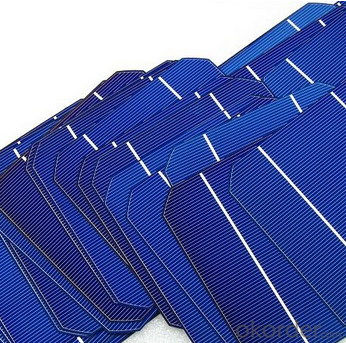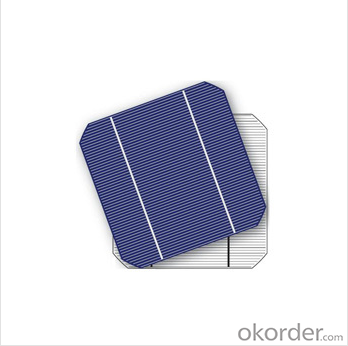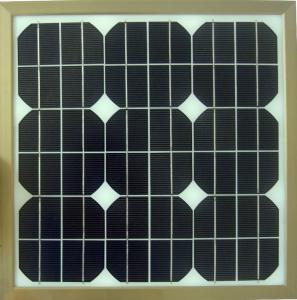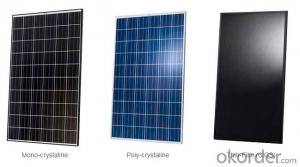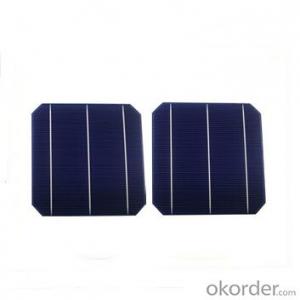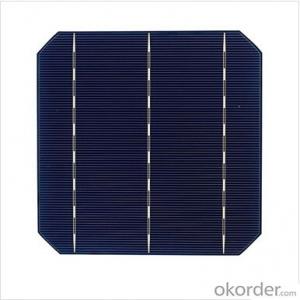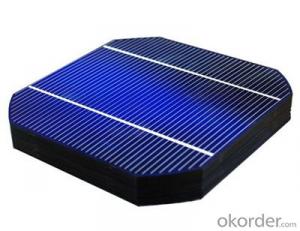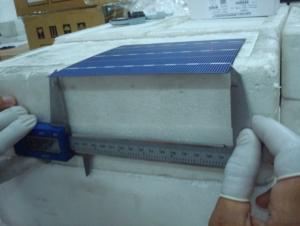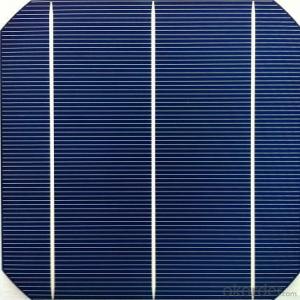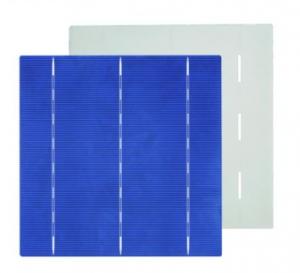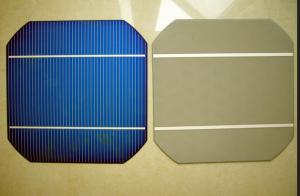Amazon Solar Cells - Monocrystalline Solar Cells ICE-1 18.2%
- Loading Port:
- China main port
- Payment Terms:
- TT OR LC
- Min Order Qty:
- 500 watt
- Supply Capability:
- 50000 watt/month
OKorder Service Pledge
OKorder Financial Service
You Might Also Like
Instruction
Format : 156 mm × 156 mm ± 0.5 mm
Thickness: 210 μm ±40 μm
Front (-) : 1.5mm bus bars (silver),blue anti-reflection coating (silicon nitride)
Back (+) : 2.5mm wide soldering pads (silver) back surface field (aluminium)
Feature
1. High efficiency and High power.
2. Long-term electrical stability.
3. Lowest price and Fastest delivery.
4. Good quality and best service.
5. Bulk supply
6. Trusted Warranty
7. Big Sale
8. More than 25 years on the lifetime.
Images
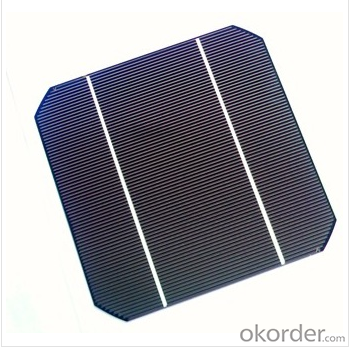

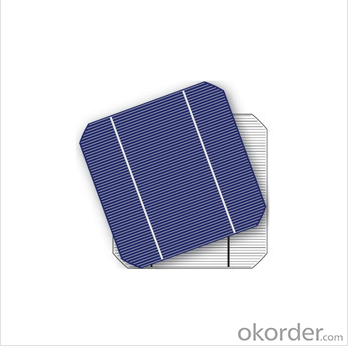
Specification
Electrical Characteristic of Mono Solar Cells
Efficiency (%) | Pmpp (W) | Umpp (V) | Impp (A) | Uoc (V) | Isc (A) | FF (%) |
18.35 | 4.384 | 0.526 | 8.333 | 0.63 | 8.877 | 78.39% |
18.20 | 4.349 | 0.526 | 8.263 | 0.63 | 8.789 | 78.54% |
18.05 | 4.313 | 0.525 | 8.216 | 0.63 | 8.741 | 78.32% |
17.90 | 4.277 | 0.524 | 8.161 | 0.629 | 8.713 | 78.04% |
17.75 | 4.241 | 0.523 | 8.116 | 0.629 | 8.678 | 77.70% |
17.60 | 4.206 | 0.521 | 8.073 | 0.628 | 8.657 | 77.36% |
17.45 | 4.170 | 0.519 | 8.039 | 0.628 | 8.633 | 76.92% |
17.30 | 4.134 | 0.517 | 8.004 | 0.626 | 8.622 | 76.59% |
17.15 | 4.098 | 0.516 | 7.938 | 0.625 | 8.537 | 76.80% |
17.00 | 4.062 | 0.512 | 7.933 | 0.625 | 8.531 | 76.18% |
16.75 | 4.002 | 0.511 | 7.828 | 0.625 | 8.499 | 75.34% |
16.50 | 3.943 | 0.510 | 7.731 | 0.625 | 8.484 | 74.36% |
FAQ
We have organized several common questions for our clients,may help you sincerely:
1. What’s price per watt?
A: It’s depends on the quantity, delivery date and payment terms of the order. We can talk further about the detail price issue. Our products is high quality with lower price level.
2. Can you tell me the parameter of your solar cells?
We have different series of cells with different power output, both from c-si to a-si. Please take our specification sheet for your reference.
3. How do you pack your products?
We have rich experience on how to pack the panels to make sure the safety on shipment when it arrives at the destination.
4. Can you do OEM for us?
Yes, we can.
5. How long can we receive the product after purchase?
In the purchase of product within three working days, We will arrange the factory delivery as soon as possible. The perfect time of receiving is related to the state and position of customers. Commonly 7 to 10 working days can be served.
A: Of course, you will be offered a good discount for big amount.
- Q: How do solar cells perform in areas with high levels of humidity?
- Solar cells generally perform slightly less efficiently in areas with high levels of humidity. This is because the moisture in the air can scatter and absorb some of the sunlight before it reaches the solar cell, reducing its overall power output. However, modern solar cell technologies have been developed to minimize this effect and maintain a satisfactory performance even in humid conditions.
- Q: What is the impact of extreme temperature fluctuations on solar cell efficiency?
- Extreme temperature fluctuations can have a significant negative impact on solar cell efficiency. High temperatures can cause the cells to overheat, leading to a decrease in their performance and efficiency. On the other hand, very low temperatures can also reduce their efficiency as the cells become less effective at converting sunlight into electricity. Therefore, it is crucial to consider temperature management in solar installations to optimize their efficiency and overall performance.
- Q: Many people said the usage of solar cell can reduce the cost overall, but does anyone agree with me that it actually cost a lot to operate a solar cell system?
- It cost less in terms of the energy waste.
- Q: How do solar cells perform in areas with high levels of volcanic ash?
- Solar cells may not perform optimally in areas with high levels of volcanic ash. The ash particles can accumulate on the surface of the solar cells, blocking sunlight and reducing their efficiency. Regular cleaning and maintenance may be required to ensure the cells continue producing electricity effectively.
- Q: What is the role of batteries in solar cell systems?
- The role of batteries in solar cell systems is to store the excess energy generated by the solar panels during the day for use during periods of low or no sunlight, such as at night or during cloudy weather. This allows for a continuous and reliable power supply from solar energy.
- Q: What is the impact of dust and dirt on solar cell performance?
- The presence of dust and dirt on solar cells can significantly impact their performance. These particles can accumulate on the surface of the cells, reducing the amount of sunlight that reaches the photovoltaic material. This reduces the efficiency of the solar cells in converting sunlight into electricity. Dust and dirt can also create shadows on the cells, causing hot spots and leading to uneven distribution of power production. Therefore, regular cleaning and maintenance of solar panels are crucial to maximize their performance and ensure optimal energy generation.
- Q: What is the role of bypass diodes in solar cell arrays?
- The role of bypass diodes in solar cell arrays is to minimize the effect of shading or partial shading on the overall performance of the array. These diodes provide an alternate path for the current to bypass the shaded or low-performing cells, ensuring that the rest of the cells can continue operating efficiently. By preventing the shaded cells from dragging down the voltage and current of the entire array, bypass diodes help maximize the power output and overall efficiency of the solar cell array.
- Q: What is the role of charge controllers in solar cell systems?
- The role of charge controllers in solar cell systems is to regulate the flow of electrical current between the solar panels and the batteries. They prevent overcharging of the batteries by monitoring the voltage and current levels, ensuring efficient charging and maximizing the lifespan of the batteries. Additionally, charge controllers protect the batteries from being drained excessively by disconnecting the load when the battery voltage drops to a certain level. Overall, charge controllers are crucial in maintaining the integrity and performance of solar cell systems.
- Q: What is the role of surge protectors in solar cell systems?
- The role of surge protectors in solar cell systems is to protect the system from voltage spikes or surges that can damage the solar panels, inverters, or other sensitive electronic components. Surge protectors help to regulate and divert excessive voltage to prevent equipment failure and ensure the overall stability and longevity of the solar cell system.
- Q: Can solar cells be used for air conditioning?
- Yes, solar cells can be used for air conditioning through the utilization of solar-powered air conditioning systems. These systems convert solar energy into electricity, which is then used to power air conditioning units, enabling cooling without relying on traditional energy sources.
Send your message to us
Amazon Solar Cells - Monocrystalline Solar Cells ICE-1 18.2%
- Loading Port:
- China main port
- Payment Terms:
- TT OR LC
- Min Order Qty:
- 500 watt
- Supply Capability:
- 50000 watt/month
OKorder Service Pledge
OKorder Financial Service
Similar products
Hot products
Hot Searches
Related keywords




